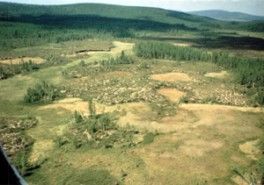
A meteor has fallen on the Urals yesterday, 1500 km from Moscow, injuring a thousand and two hundred people. Fortunately, that was just a small stone that exploded in mid air, breaking up, due to a high speed and heat.
This is not a completely new event and people of the news remind this fact to us during their presentations, speaking of Tunguska, but without going into details. We try to provide a few details here.
Indeed there is a similar episode happened one hundred and five years ago in an area not far from Chelyabinsk, in the Urals.
Tunguska is the name of the place and the sky did fall down, literally, on the 30th of June 1908 at 7: 40 AM. This place is about 700 kilometres far from Irkutsk in Siberia.
What happened there was indeed a unique catastrophic event, but in spite of all the research put up since then, there is no certainty about what exactly hit our Planet. The effects were similar to an atomic explosion, but no isotopes were ever found, so it cannot be a natural nuclear chain reaction. As a matter of fact traces of an atomic explosion, 1.8 million years old, were found in Africa. If we exclude an extraterrestrial intervention (here the movie ‘Planet of the Apes’ comes to mind) then we must conclude that it was a natural phenomenon cause by an high quantity of Uranium in the soil, which created a critical mass.
What we know for certain is that the mysterious thing, which hit Siberia that morning, shook the Earth and disturbed its magnetic field. In Nord-Est Europe, for a few days, a strange blue luminosity was noticed at the sunset and the barometers gave strange readings. In Germany the instruments recorded sound waves travelling at high speed around the Earth. Our grandfathers suspected that a great volcanic eruption, similar to the Kracatoa explosion, recorded just 25 years before, had happened again. Some journalist wrote about it on their papers but then all was forgotten.
Scientists reached that remote region of Siberia only 19 years later and found a circular range with a diameter of 30-40 kilometres where all trees had fallen, but in a strange way, at the centre they were still pointing skyward while around they were sucked forward, not backward and their bark had disappeared. They found some old witness among the local Tungus and the few exiles sent there by the Zarist regime. The first scientist to reach the area in 1929 was Leonid Kulik, a geologist, by profession, who spoke to a farmer that was at 65 kilometres far from the impact area and could remember very well that morning. He told him that he was sitting outside his shack and suddenly he saw ahead of him a blinding light and then he felt burning heat on his face, his cotton shirt catch fire. Then darkness fall and a thundering bang caused pain to his ears and threw him on the ground. He fainted but waking quickly up he could still hear a rumbling noise coming from afar then he found that all glasses were shattered and his shack had been moved backward by a couple of meters.
The fall of some kind of meteorites could explain a part of the phenomenon of the hit but not all. In particular Vasily Fesenkov, a Russian expert in meteorites, who wrote about Tunguska thought that such trajectory of impact was impossible. A meteorite could not hit the Earth at that hour of the morning in that particular place, as meteorites go around the sun in anti clockwise direction. Perhaps it was a comet, he thought and the iced gas inside which could have provoked such huge explosion.
More recently a detailed study was carried out by three American physics with a first class reputation: Willard Libby, a Nobel Prize for Physics; Clyde Cowan, one of the first scientists to describe the behaviour of neutrinos and an assistant of Libby. They carried out an ambitious and detailed study of the entire hypothesis considered for Tunguska.
They put aside the Comet’s hypothesis because of its size and short angle of impact, as it should have been clearly visible in the sky before that smashing hit.
According to them a viable idea could be a hit by an anti-matter body. They indeed discovered that during the year 1909 the quantity of C14 in the trees was higher than normal – if anti-matter was, then that isotope should have been very high. They found a higher than normal quantity of C14 but not high enough.
Then we have a study by Jackson and Ryan of the University of Texas. They came up with the fanciful idea that it could have been a micro black hole travelling in space, this mean a fast and invisible body. The first burst of light should have been in the field of UV spectre, which could explain the blue light that was observed as far as London.
The idea of a meteorite (a spent comet) had been revived recently with a research carried out on site by Italian scientists six years ago, and this seems the most probable hypothesis.
Photo: Tunguska’s epicentre in 2008. The scars are still visible.

1 commento su “FROM RUSSIA, WITH A BANG!”